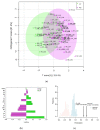Identification of Soil Properties Associated with the Incidence of Banana Wilt Using Supervised Methods
- PMID: 35956549
- PMCID: PMC9370614
- DOI: 10.3390/plants11152070
Identification of Soil Properties Associated with the Incidence of Banana Wilt Using Supervised Methods
Abstract
Over the last few decades, a growing incidence of Banana Wilt (BW) has been detected in the banana-producing areas of the central zone of Venezuela. This disease is thought to be caused by a fungal−bacterial complex, coupled with the influence of specific soil properties. However, until now, there was no consensus on the soil characteristics associated with a high incidence of BW. The objective of this study was to identify the soil properties potentially associated with BW incidence, using supervised methods. The soil samples associated with banana plant lots in Venezuela, showing low (n = 29) and high (n = 49) incidence of BW, were collected during two consecutive years (2016 and 2017). On those soils, sixteen soil variables, including the percentage of sand, silt and clay, pH, electrical conductivity, organic matter, available contents of K, Na, Mg, Ca, Mn, Fe, Zn, Cu, S and P, were determined. The Wilcoxon test identified the occurrence of significant differences in the soil variables between the two groups of BW incidence. In addition, Orthogonal Least Squares Discriminant Analysis (OPLS-DA) and the Random Forest (RF) algorithm was applied to find soil variables capable of distinguishing banana lots showing high or low BW incidence. The OPLS-DA model showed a proper fitting of the data (R2Y: 0.61, p value < 0.01), and exhibited good predictive power (Q2: 0.50, p value < 0.01). The analysis of the Receiver Operating Characteristics (ROC) curves by RF revealed that the combination of Zn, Fe, Ca, K, Mn and Clay was able to accurately differentiate 84.1% of the banana lots with a sensitivity of 89.80% and a specificity of 72.40%. So far, this is the first study that identifies these six soil variables as possible new indicators associated with BW incidence in soils of lacustrine origin in Venezuela.
Keywords: calcium; clay; iron; machine learning; random forest; zinc.
Conflict of interest statement
The authors declare no conflict of interest.
Figures








References
-
- FAOSTAT Database Food and Agriculture Organization Statistic. [(accessed on 14 March 2022)]. Available online: https://bit.ly/34z8QN8.
-
- Deacon J.W., Herbert J.A., Dames J. Fals Panama disorder of bananas. Citrus Subtrop Fruit Inst. Inf. Bul. 1985;149:15–18.
-
- Rey J.C., Martínez G., Pizzo N., Micale E., Fernández N. Susceptible areas to false Panama disease in Cavendish bananas, in the Central Region of Venezuela; Proceedings of the Reunión Internacional ACORBAT; Miami, FL, USA. 19–22 April 2016.
-
- Domínguez J., Negrin M.A., Rodriguez C.M. Soil potassium indices and clay-sized particles affecting banana-wilt expression caused by soil fungus in banana plantation development on transported volcanic soils. Commun. Soil Sci. Plant Anal. 2008;39:397–412. doi: 10.1080/00103620701826522. - DOI
Grants and funding
LinkOut - more resources
Full Text Sources

